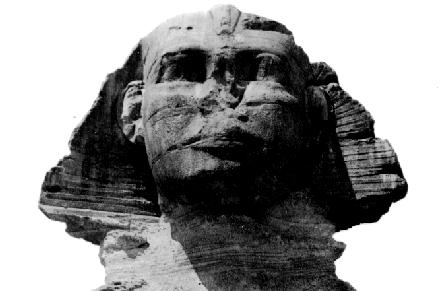Exhibit 1

(C) collection R. Vergnieux.
A postcard of the noseless Sphinx from 1910. This postcard is from the Service Informatique et Recherches en Archéologie archives.
 You can't harmonize with the dark people of the world who out number you eleven to one, if you're going to stand in the mind of white supremacy. White supremacy has to die in order for humanity to live.. White folk try to rewrite history and write us out. White supremacy caused Napoleon to blow the nose off of the Sphinx because it reminded you too much of the Black man's majesty.
You can't harmonize with the dark people of the world who out number you eleven to one, if you're going to stand in the mind of white supremacy. White supremacy has to die in order for humanity to live.. White folk try to rewrite history and write us out. White supremacy caused Napoleon to blow the nose off of the Sphinx because it reminded you too much of the Black man's majesty. Anyone may believe these Eqyptian tales, if he is sufficiently credulous; as for myself, I keep to the general plan of this book, which is to record the traditions of the various nations just as I heard them related to me.
Anyone may believe these Eqyptian tales, if he is sufficiently credulous; as for myself, I keep to the general plan of this book, which is to record the traditions of the various nations just as I heard them related to me.Louis Farrakhan is relating a common "urban legend" that someone removed the nose of the Sphinx, typically by means of a cannon.
There a couple of constants to this legend. First, the protagonist is usually associated with military despotism. Second, the legend assumes the Sphinx's nose was largely intact before the protagonist came along, both questionable assumptions given that the Sphinx dates from the reign of Khafre 2520-2494 B.C., is constructed of soft limestone, and has been exposed to a harsh climate for thousands of years and that Egypt has been occupied by a number of different armies over the course of its history.
Napoleon's troops shot the nose off the Sphinx in 1798:
British troops shot the nose off the Sphinx during:
German troops shot the nose off the Sphinx during World War II.
The Mamelukes shot the nose off the Sphinx.
Arab conquerors knocked the nose off the Sphinx in 693.
An Islamic cleric, Sa'im al-dahr, had the nose knocked off the Sphinx in 1378.
Time
Erosion
Weather
These legends involving human destruction of the Sphinx's nose often ignore the fact that a large unsupported piece of soft limestone dating from 4500 B.C.E. is unlikely to survive the elements in a pristine state.
NOT GUILTY: Napoleon's troops. The Sphinx was well known to Europe and no contemporary account describes the Sphinx having a nose before Napoleon arrived and being in a noseless condition after his departure. Napoleon was not popular with Britain and they certainly would have made propaganda hay of it had it occurred during Napoleon's stay.
NOT GUILTY: British troops have an alibi.
NOT GUILTY: German troops have an alibi.
UNKNOWN: the Mamelukes
UNKNOWN: Arab conquerors
UNKNOWN: Islamic cleric, Sa'im al-dahr
Both Arab conquerors and Sa'im al-dahr are described in contemporary accounts as doing violence to the Sphinx. In Sa'im al-dahr's case, the nose is specifically mentioned. It is difficult to judge the state of the nose before and after their actions (assuming the accounts are true.)

(C) collection R. Vergnieux.
A postcard of the noseless Sphinx from 1910. This postcard is from the Service Informatique et Recherches en Archéologie archives.

Better yet, an image of the noseless Sphinx from 1886. See the entire image at from the archives of the Griffith Institute.
Vote early! Vote often! Cast your votes for the culprit of your choice! See the latest results!
I welcome any comments, sources, pointers to historical images of the Sphinx's nose
that you may have. Please send them to me!